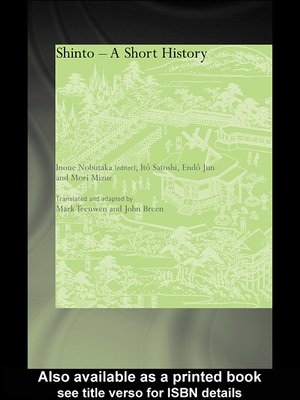
Sign up to save your library
With an OverDrive account, you can save your favorite libraries for at-a-glance information about availability. Find out more about OverDrive accounts.
Find this title in Libby, the library reading app by OverDrive.



Search for a digital library with this title
Title found at these libraries:
| Library Name | Distance |
|---|---|
| Loading... |
Shinto - A Short History provides an introductory outline of the historical development of Shinto from the ancient period of Japanese history until the present day.
Shinto does not offer a readily identifiable set of teachings, rituals or beliefs; individual shrines and kami deities have led their own lives, not within the confines of a narrowly defined Shinto, but rather as participants in a religious field that included Buddhist, Taoist, Confucian and folk elements. Thus, this book approaches Shinto as a series of historical 'religious systems' rather than attempting to identify a timeless 'Shinto essence'.
This history focuses on three aspects of Shinto practice: the people involved in shrine worship, the institutional networks that ensured continuity, and teachings and rituals. By following the interplay between these aspects in different periods, a pattern of continuity and discontinuity is revealed that challenges received understandings of the history of Shinto.
This book does not presuppose prior knowledge of Japanese religion, and is easily accessible for those new to the subject.
Shinto does not offer a readily identifiable set of teachings, rituals or beliefs; individual shrines and kami deities have led their own lives, not within the confines of a narrowly defined Shinto, but rather as participants in a religious field that included Buddhist, Taoist, Confucian and folk elements. Thus, this book approaches Shinto as a series of historical 'religious systems' rather than attempting to identify a timeless 'Shinto essence'.
This history focuses on three aspects of Shinto practice: the people involved in shrine worship, the institutional networks that ensured continuity, and teachings and rituals. By following the interplay between these aspects in different periods, a pattern of continuity and discontinuity is revealed that challenges received understandings of the history of Shinto.
This book does not presuppose prior knowledge of Japanese religion, and is easily accessible for those new to the subject.







